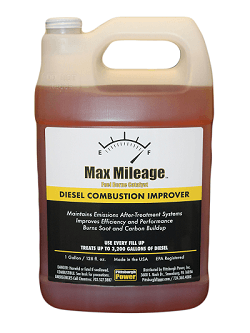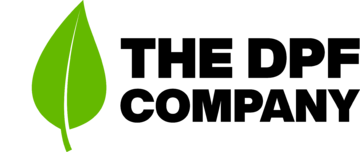MAX MILEAGE
FUEL BORNE CATALYST
Better Results
Max Mileage fuel borne catalyst increases the thermal efficiency of any engine by an average of 10%. It accelerates the burn rate of diesel molecules so that more BTU's of heat are released earlier during the power stroke instead of being wasted as soot and high exhaust gas temperature.
Burn Soot
Once Max Mileage has entered the exhaust system, the catalyst will continue to work by burning soot at a much lower temperature, 750 degrees Fahrenheit compared to 1000 degrees (the normal ignition temperature for soot).
New Technology
The Max Mileage proprietary mixture is supplemented with a fuel injector cleaner that removes fuel injector coking deposits and prevents new deposits from forming. This is critical to maintaining factory-rated fuel economy by ensuring optimal fuel "atomization" and fuel injector spray patterns in the cylinder
BENEFITS OF MAX MILEAGE
CUT SOOT EMISSIONS BY 60%
Say goodbye to soot related "check engine lights." If you have a 2007 and newer truck, you can keep your truck legal without sacrificing reliability.
REDUCE DEF CONSUMPTION
With lower EGT, less DEF (Diesel Exhaust Fluid) is used. Yet another way the product more than pays for itself

BETTER FUEL MILEAGE 3% - 10%
Results may vary, but typically after the first few weeks many notice an improvement in fuel mileage due to the more efficient combustion.
EXTENDS ENGINE LIFE
Soot is the enemy of any diesel engine. It's abrasive and harmful to your engine's rings and liners. Max Mileage will lower the soot levels in your oil sample.
FAQ
See some common questions and answers below, or call us at 800 778 0125
- Can I use it for my truck, car and tractor?
Yes, it can be used for any diesel engine.
- Can I use it for my gas engine?
Yes, but please change the ratio to 1 ounce for every 30 gallons. it has anti-knock properties so it works well for classic cars.
- How is this different from other fuel additives?
Be assured, there is no other product on the market with the same active ingredients. No other product can come close when it comes to reducing soot and all the benefits that follow.
- Will Max Mileage FBC work for my pre-emissions heavy duty diesel engines?
Yes, it works the same way in all diesel engines to improve combustion on average by ~10%. The main results are better fuel economy and dramatically lowered exhaust emissions as demonstrated by validated test procedures.
- Can I mix with other fuel additives?
Yes, it's safe to mix with all other fuel additives. But please DO NOT mix it directly with other additives, instead let them mix in the tank.
- Will I see changes to my oil sample?
Yes, you may see an increase in Iron. This is nothing to worry about as long as other wear metals stay consistent
- Can iron deposits from Max Mileage hurt my engine?
No. The iron-containing molecules in Max Mileage FBC are fully dissolved as a liquid ingredient, similar to iron in your blood. It’s also diluted to just a few PPM so it cannot cause any damage due to frictional wear in the high pressure fuel pump and fuel injectors. Max Mileage's EPA testing concluded there are no negative effects from long term use.
- Why is Max Mileage so expensive?
At the suggested dilution, a bottle of Max Mileage will treat 3200 gallons of fuel, costing you only $.07/gallon. Besides the expensive ingredients that go into the catalyst, there is considerable research and development that went into formulating the product. Of course, the benefits you realize from using Max Mileage provide a substantial return on your investment.
- Max Mileage FBC is on the EPA list of registered fuel additives under CFR Part 79. What does this mean?
This means that Max Mileage FBC meets or exceeds EPA criteria for demonstrating no harm to either engines or the environment and is approved for use in all US road diesel.
- What is this red-orange residue on my DPF filter?
Because of the absence of the oily black soot coating on the DPF it is easy to see the red-orange discoloration that results from the iron ingredient over many thousands of miles driven. This will be removed with periodic cleaning of the DPF as recommended by the engine manufacturer just like other ash (metallic) residues from other sources, including engine oil, coolant, dust and dirt, and rust contaminated fuel.
- Will Max Mileage FBC eliminate ash deposits in my DPF?
Max Mileage FBC is designed to reduce and/or eliminate soot deposits. Soot is the primary culprit for DPF regeneration problems as well as premature engine wear and emissions system failures in modern diesel engines. Unlike soot, ash cannot be burned off. Total ash from all sources (fuel contamination, engine oil additives, dirt and dust) only makes up a very small fraction of the incoming soot, typically less than 5%. Ash remains in the DPF as an incombustible material left behind following the DPF regeneration process and builds up over very long periods of time. Therefore, ash must be periodically removed via shop cleaning.
- How does Max Mileage FBC decrease my DEF usage?
Simply put, a more efficient engine will produce less NOx. Max Mileage FBC significantly increases the thermal efficiency of ANY engine, with or without emissions after treatment systems. In newer engines, the SCR system injects DEF fluid into the exhaust corresponding to the amount of NOx measured by the NOx sensor. Because the catalyst lowers NOx levels by 15% on average, the ECM responds by sending a signal to the SCR to inject less DEF, correspondingly.
- I have an “in-service” engine. How long will it take for Max Mileage FBC to burn out carbon deposits and soot build-up in my engine and exhaust system?
Describe the item or answer the question so that site visitors who are interested get more information. You can emphasize this text with bullets, italics or bold, and aThe “clean-out’ effect of Max Mileage FBC for an in-service diesel engine can take 4 to 6 weeks, on average, to complete. This means that initially, the DPF sensors may react to higher levels of smoke being produced internally as the soot is being burned off at a lower temperature with the help of the fuel catalyst. In some cases, especially for very high mileage engines, things may appear to get worse before they get better. This is normal and should pass without resulting in an engine “derate” situation. dd links.
- Is Better Diesel FBC approved by CARB for use in California road fuels?
Yes.
- What is my cost for Max Mileage FBC?
At the suggested treat ratio, one gallon of Max Mileage FBC will treat 3200 gallons of fuel at a cost of around $.07/gallon of fuel. This translates to approximately $0.01/mile of cost assuming a baseline for fuel consumption of 7 MPG. Our product has been verified to produce tangible benefits that translate to lower cost of ownership of heavy duty transport trucks. The ROI (Return on Investment) can range anywhere from 300% to 800%, depending on the type of engine and mode of operation. The maximum investment for a typical OTR truck owner will be 4 to 5 gallons of Max Mileage FBC at a cost of $1,000 – $1,500 per year. Savings accrue through reduced fuel costs, reduced DEF consumption (if applicable), and less down-time especially from exhaust after-treatment system repairs (if applicable). All diesel engines potentially will have extended longevity due to reduced engine wear due to soot and the accumulation of carbon deposits.
- Does Max Mileage FBC have any effect on the lubricity of diesel?
No, our independent tests using ASTM D6079 demonstrate that Max Mileage FBC has no measurable effect on the lubricity of diesel fuel.
Contact Us
We will get back to you as soon as possible.
Please try again later.
We are a Canadian based company that can clean and restore all makes and models of DPF filters. We offer multiple levels of environmentally safe filter cleaning service.
PRODUCTS
LOCATIONS
© 2021. All Rights Reserved by The DPF Company




